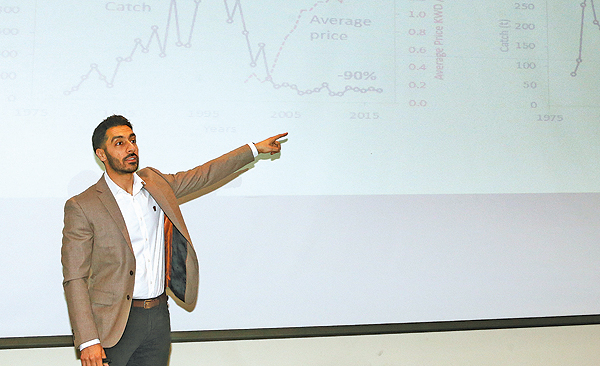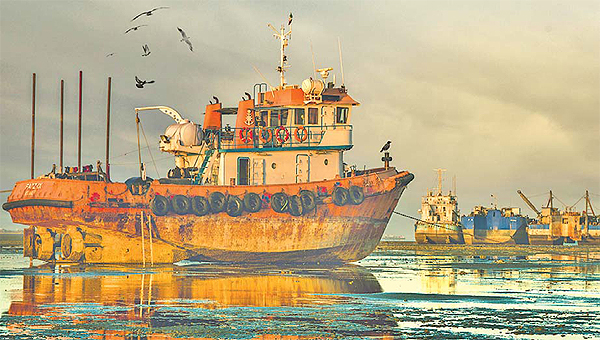KU hosts seminar on fisheries, fish catches decline

KUWAIT: The Department of Marine Science at Kuwait University (KU) hosted a seminar titled 'The boom and bust of Kuwait fisheries - why fish catches are declining' on Tuesday at its premises. It was presented by Abdulrahman Ben-Hasan, PhD candidate at the University of British Columbia. He spoke about Kuwait's fisheries, defining it as the interaction between fishing gear and fish. "This includes trap fishing and shrimping. Fisheries in Kuwait have three forms - bottom trawling fishing that is the most valuable and targets shrimp and fish. Gillnet fishing targets pelagic species including zubaidi, suboor, nuwaibi, and maid. Gargoor trap fishing targets demersal species including hamoor, hamra, shaem and shiery," Ben-Hasan said.
Catches of most commercial species have declined sharply since 1995, with the decline of suboor the most dramatic. "Prices increased tremendously - by over 366 percent - of suboor from 1995, while catches dropped by 90 percent. For nuwaibi, the price hiked by 229 percent and the catch dropped by 72 percent, zubaidi's price hiked by 136 percent and its catch dropped by 87 percent, and so on," he explained. "There are no signs of recovery and the average price keeps increasing, with more than 100 percent relative to 2001 prices, which shows economically successful fisheries. But when we look at the huge declines in catches, we see it is more distinctive than successful fishery," he added.
Overfishing
The first suspect behind catch declines is overfishing. "Overfishing is harvesting fish stock at a rate higher than natural reproduction. In extreme overfishing, the population will continue to decline and could become extinct. In Kuwait, we suffer from Malthusian overfishing, which is too many fishermen chasing too few fish," said Ben-Hasan.
In Kuwait, fishing typically operates under an open-access regime with certain input controls. "We have no license limitation programs in our fisheries and no output controls, which mean there is no quota that is applied in developed countries. Regulations are weakly enforced, and fisheries are subsidized both directly and indirectly. Subsidies make fishing cheaper," he noted.
"Over the last 10 years, shrimp averaged around 40 percent of the total catch. In 2012, Kuwait's shrimp stock experienced overfishing. Hamoor is another example of overfishing - we estimate its declining trend due to very high and unsustainable fishing pressure. The normal pressure should be taking around 10 percent of the population, but actually we are taking around 30 percent of the population each year," he further said.
The second suspect is the environment. "There are too many cases where reductions in fishing have completely failed to result in the desired recovery. On the west coast of Canada, complete closures of major fisheries for 20 years have been implemented since the mid-1990s with no signs of recovery, as the fish didn't come back," said Ben-Hasan.
Marine environmental issues
"We have coastal development and landfills, discharge of untreated sewage, release of significant amount of brine associated with desalination plants and reduction of the freshwater flow of Shatt Al-Arab due to dams. This is mainly due to two reasons - river-sea interaction and fish abundance. The higher freshwater flow causes higher catches. The problem is in damming the Tigris and Euphrates rivers," he added.
Today, the Shatt Al-Arab's flow is very weak. "Drought and dams allow saltwater to invade, threatening people and the ancient marshes of Mesopotamia. The flow rate of Shatt Al-Arab has been drastically reduced, which caused significant increase in salinity levels in the northern Gulf. The Shatt Al-Arab is ecologically important - it is a nursery habitat for many commercial species, transports essential nutrients and lowers excessive salinity, while the magnitude and seasonality of the Shatt Al-Arab trigger important biological events. Three decades of monitoring indicated that salinity has increased and has currently leveled off around 42 psu," he explained.
It's not known what's causing the catch declines. "By re-evaluating the hamoor overfishing case, maybe it's the environment. It's important to know the answer, as it will help managers implement effective regulations. Human interactions with nature should be experimental and adaptive, because human understanding of nature is imperfect. I'm proposing here to use this concept of adaptive management to tease apart the confounding effects of overfishing and environment," Ben-Hasan pointed out.
Continued fishing is the default policy option. "Reduced fishing can be viewed as an experimental policy option with some promise for improving future yields. If 'reduced fishing' increases the biomass of fish stock, then fishing is the main cause of the declining catches, if not, then it is the environment," he said.
He concluded by saying that although Kuwait fish catches continue to decline with no signs of recovery, management measures are absent. "In 2016, the Gulf was intruding up to 100 km inland, implying that the Shatt Al-Arab flow is very weak, which is extremely worrying. To get the management part right, we need to know what is causing the decline in fish catches; one way to do this is by using adaptive management," concluded Ben-Hasan.
By Nawara Fattahova











